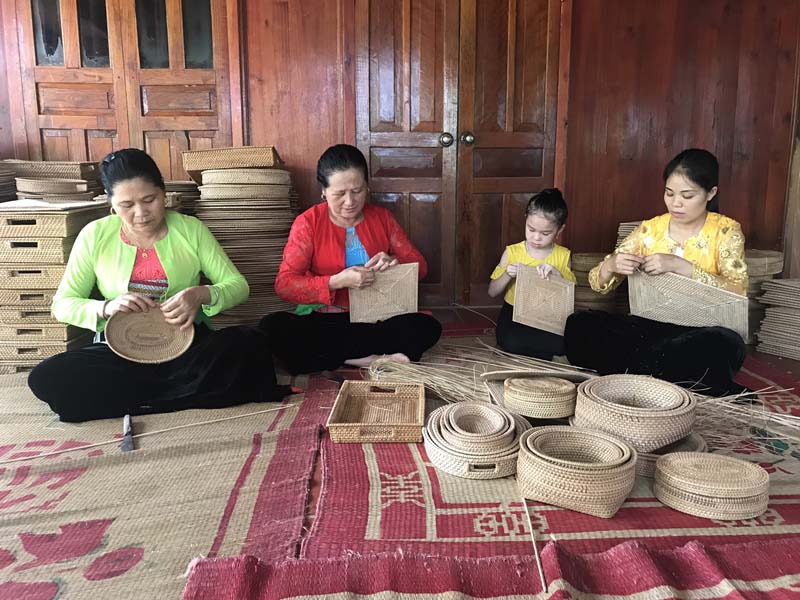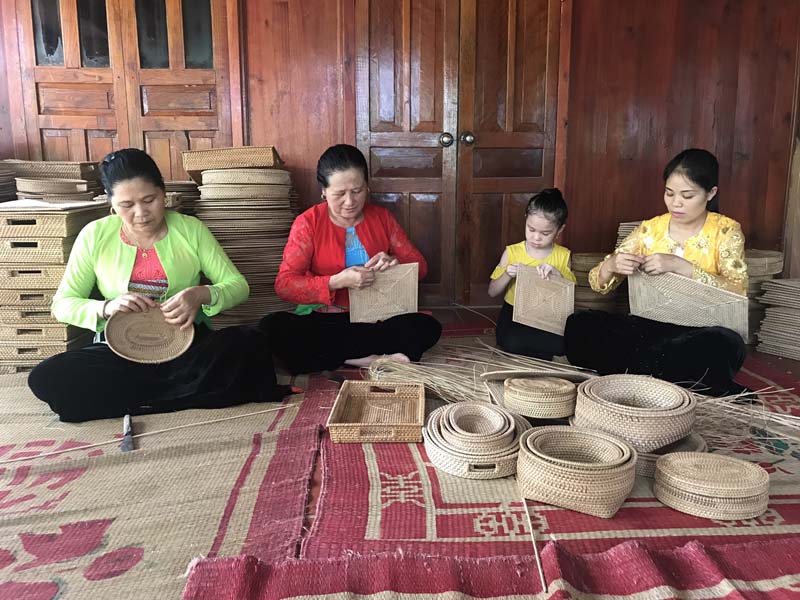
(HBO) - Rattan and bamboo weaving in Bui hamlet of Nhan Nghia commune (Lac Son district) dates back hundreds of years. Over generations, local craftsmen have always worked hard to ensure sophistication and uniqueness of each product.
Bamboo weaving sustained in Bui hamlet.
Well aware of the importance of the trade to economic
development and cultural identity conservation, local authorities have been
striving to gradually revive this traditional craft, thereby helping to reduce
poverty, improve income and create jobs for rural residents.
The rattan and bamboo craft village of Bui
hamlet, officially recognised on December 17, 2017, is providing stable jobs
for more than 350 locals with an average per capita income of 2 – 3 million VND
(86.4 – 129.5 USD) each month. It has been operating fruitfully, producing
items, mostly handmade, with diverse designs and ensured quality. As a result,
local products have won preference in the market, and the village has received
a number of big orders from across Vietnam, as well as other countries like
China and Japan.
Quach Thi Dung, head of the rattan and bamboo
craft village of Bui hamlet said: "This traditional craft village dates back to
a long time ago, but it used to fall into oblivion. I and other people have
strived to revitalise the traditional craft. The first steps were very
difficult, but thanks to the support of authorities of all levels, the rattan
and bamboo craft village was set up. It has attracted 170 households with over
350 workers to producing rattan and bamboo items. There remain numerous
difficulties in production development such as those relating to materials,
kilns, bleaching facilities, cutting machines and other equipment. We hope that
authorities will create more favourable conditions for the village to further develop.”
In the face of changes in the modern life,
rattan and bamboo weaving was sometimes thought to be unable to survive. Thanks
to their enthusiasm and dedication, the skilled craftsmen have been determined
to maintain this craft with the hope of seeking a firm foothold for it.
Bui Thi Thu Dung, a member at the rattan and
bamboo craft village of Bui hamlet said: "I began making rattan and bamboo
items when I was a small girl. My grandmother and mother taught me this craft.
I weave products to make use of my spare time and also raise my family’s
income.”
It takes craftsmen lots of steps and meticulousness to create a rattan and bamboo
item. Through their skilful hands, simple materials are transformed into fine
and colourful products imbued with cultural identities.
In the past, rattan and bamboo goods were made
mainly to serve daily needs of families. Recently, authorities of Nhan Nghia
commune have organised training courses to help craftsmen create new products
to meet the market’s rising demand such as flower baskets, lampshades or candy
containers with diverse designs.
Bui Duc Ngu, Chairman of the People’s Committee
of Nhan Nghia commune said: "Rattan and bamboo weaving has greatly contributed
to socio-economic development of the commune because it is a local traditional
craft which every people, from the elderly to teenagers, can practice, thus
helping to improve their income during their idle time. More and more people
have engaged in this craft.”
To maintain the rattan and bamboo weaving craft
of Bui hamlet, it is necessary to continue improving craftsmen’s skills, equip
them with modern machinery to better product quality and design, expand the
market and enhance products’ competitiveness so that the traditional craft is
conserved and developed, and the standing of traditions is further consolidated
in the modern life./.
The People’s Committee of Lac Son district held a ceremony on April 28 to receive the provincial relic certificate for the ancient rock carving site at Suoi Co stream, located in My Thanh commune.
A special music show titled "The country is in the fullness of joy” has been held at Hoa Binh Square in Hoa Binh city in celebration of the 50th anniversary of the liberation of the South and national reunification (April 30, 1975–2025).
The People's Committee of Lo Son commune, Tan Lac district, has organised the local annual traditional stream fishing festival on April 19 - 20.
As a land deeply intertwined with human history and Vietnam’s millennia-long journey of nation-building and defence, Hoa Binh is often revered for its epic tales and legends.
Residents of Hoa Binh boast a rich cultural identity, reflected in their unique language, traditional attire, customs, and folk melodies – described as "sweet as honey, clear as a mountain stream.”
Lac Son district’s Vu ban town held the 2025 Truong Kha temple festival on April 12–13 (the 15th–16th days of the third lunar month). Since its revival in 2019, the festival has been organised every three years, preserving valuable intangible heritage while meeting the community’s cultural and spiritual needs.



